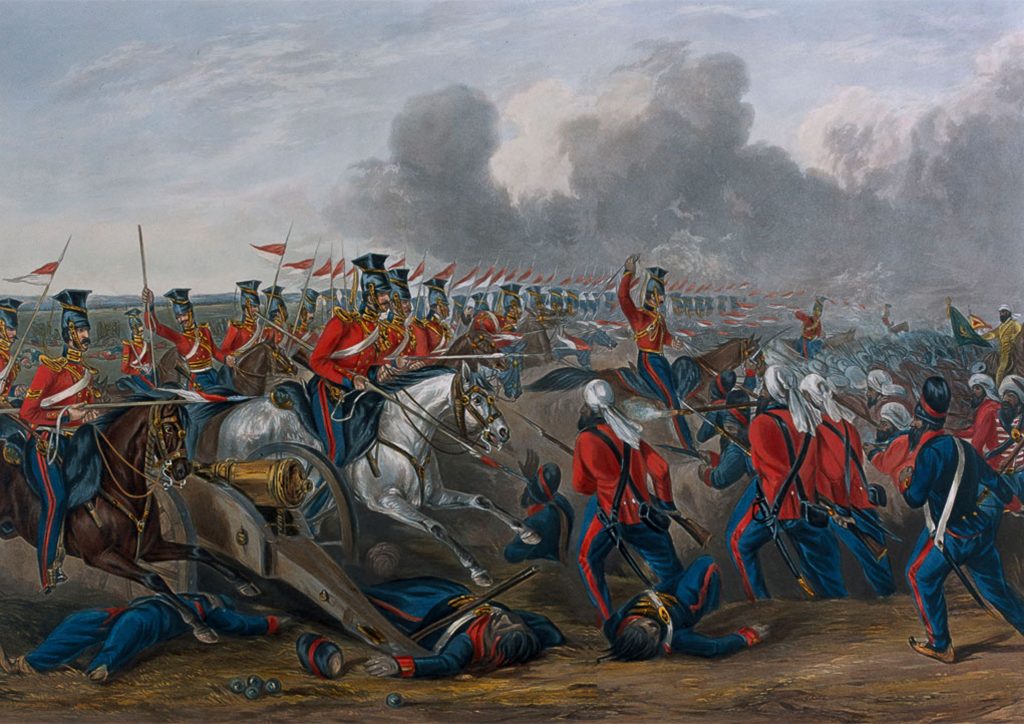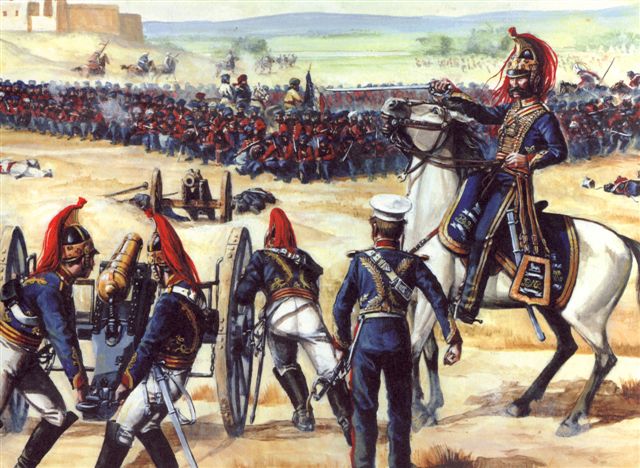The Battle of Aliwal

HM 16th Queen’s Lancers charging the Sikh infantry at the Battle of Aliwal. Sergeant Newsome leads the front rank.
Harry Smith with little difficulty captured two small forts occupied by the Sikhs on the south bank of the Sutlej River, Fategarh and Dharmkot, and moved on towards Ludhiana. Ahead of him Ranjodh Singh was following much the same route but with little apparent urgency.
Gough reinforced Smith with the HM 16th Lancers who were very influential in the battle and another battery of guns. He was ordered him to march to Jagraon on the more southerly road, where he was to take under his command HM 53rd Foot. He was then marched to Ludhiana, where he would find Colonel Godby with four native regiments, including two battalions of Gurkhas (later the 1st and 2nd Gurkha Rifles), and four guns.
Ranjodh Singh Majithia was joined by Jodha Ram’s (Avitabile’s) Brigade, Ghorcharra Khas Derah, Fateh Singh’s Mubarak Khan Artilery Brigade. With both sides entrenched at Aliwal. Brigadiers Goadby and Hicks managed to capture the Aliwal outpost which was manned by Dogra irregulars. Major Lawrenson and Brigadier Stedman charged into the Sikh line which collapsed. The Sikhs infantry then formed squares which this battle is synonymous with. Avatabile unit began to form squares to repel the cavalry attack. This is a classic maneuver, with two or three lines of infantry, bristling with bayonets and trained to deliver horrific volleys to take out attacking horsemen. The Avatabile Regiment, however, formed their “square” in a triangular formation. The 16th Lancers then came head to head with the Ghorcharras. Captain Bere and Captain Fyler then charged the Sikh square, they charged again to break the Sikh formation. This led to the Avitabile regiment retreating. Captain Daniel Henry Mackinnon, wrote
Those troops, the pupils of Avitabile, did credit that day to themselves and their master; and, however we may abhor their treachery and thirst of blood, displayed in the revolutionary annals of the Punjaub since the death of the old Lion of Lahore, we must at least bear witness to their resolute courage and soldierlike bearing.
Military service and adventures in the far east: including sketches of the campaigns against the afghans in 1839, and the Sikhs in 1845-6.

Depiction of the Sikh Squares portrait and copyright of Michael Perry
The British went to capture the village of Bhundri and the heavy fighting took place around the Bhudah Nulla. The Sikhs retreated and the battle was over. The Sikhs dead was far less then the 3000 claimed by the British. The Sikh Guns were captured by the British. The 16th Lancers suffered the most casualties. The war would now move to Sobroan.
